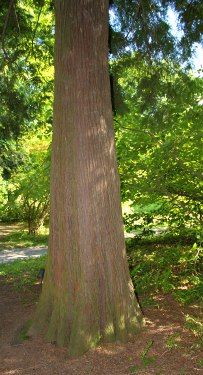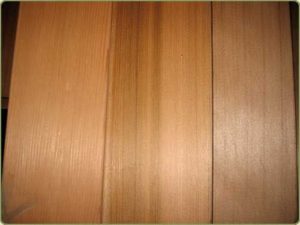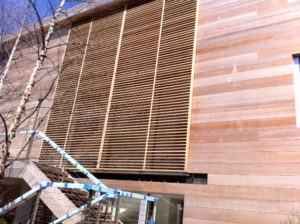Western Red Cedar
Thuja Plicata

Although not a true Cedar, Western Red Cedar shares many of the same properties and has therefore been given the cedar name. The Red Cedar is actually from the Cypress family, and it is often spelled “Redcedar” as one word as a way of indicating this.
Western Red Cedar has a wide growth range along the west coast of the US and Canada, but despite its numbers, scarcity has been a concern due to the ever growing demand for this outstanding exterior species. Through greater awareness and more responsible forestry practices, however, the supply is becoming much more balanced. These days, the replanting rates are 5 to 1, which means that we will have more Red Cedar in 50 years than we have ever had before.
Western Red Cedar Lumber
Western Red Cedar lumber is naturally rot resistant due to high levels of extractives which act as a natural fungicide. The tree has a very straight bole and high branches, which result in very few knots and a dead straight grain. Western Redcedar sapwood is very narrow, usually only 1 inch wide, whereas common trunk diameter is 2 to 8 feet. This yields large quantities of lumber with very little wastage during sawing. The lumber is very stable once dried, and although the drying process can be rather tricky, J. Gibson McIlvain’s specialists are trained to pay close attention during the kiln drying process.
The beauty of Red Cedar lumber is in the strength imparted from its long, straight grain combined with its low density, which makes it very light. The straight grain lends itself to riving, hence the common nickname “shingle wood.” The heartwood has a low sap content and does not blunt or gum on cutting tools.

Western Red Cedar Uses
Today, Western Redcedar is used extensively in the production of cedar shingles, exterior siding and trim, outdoor furniture and structure, decking, and even interior millwork and trim for those who desire a great rustic look. Its weather resistance allows for direct contact with the ground, so it is often used as fence posts, garden pergolas, and sheds, as well as in trellis applications.

J. Gibson McIlvain supplies a wide variety of Western Redcedar products. With so many applications and personal tastes among our buyers, we carry a variety of different grades. For our siding and trim, we stock only clear vertical grain, STK (select tight knot), or C and better grades. In timbers, we sell only #2 and better in appearance and clear grades.
Essentially, only the highest quality grades are what you will find at J. Gibson McIlvain. We have a staff dedicated to softwood products who can help you purchase the best Western Redcedar for whatever your project demands.
Red Cedar Lumber Specifications
| Character | Green | Dry | Units |
| Bending Strength | 5250 | 7700 | psi |
| Crushing Strength | 260 | 495 | psi |
| Max Crushing Strength | 2770 | 4770 | psi |
| Static Bending | 3100 | 5100 | psi |
| Impact Strength | 16 | 17 | inches |
| Stiffness | 995 | 1155 | 1000 psi |
| Work to Maximum Load | 5 | 6 | in-lbs/in3 |
| Hardness (Janka) | – | 350 | lbs |
| Shearing Strength | – | 990 | psi |
| Specific Gravity | 0.31 | 0.35 | – |
| Weight | 28 | 23 | lbs/ft3 |
| Density | – | 23 | lbs/ft3 |
| Radial Shrinkage | – | 2 | % |
| Tangential Shrinkage | – | 5 | % |
| Volumetric Shrinkage | – | 7 | % |


